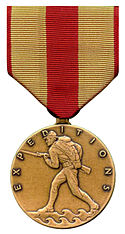Marine Corps Expeditionary Medal
This article needs additional citations for verification. (November 2008) |
| Marine Corps Expeditionary Medal | |
|---|---|
 | |
| Type | Medal |
| Awarded for | Land on foreign territory, engage in operations against armed opposition, or who operate under circumstances deemed to merit special recognition and for which no campaign medal has been awarded. |
| Presented by | the Department of the Navy[1] |
| Eligibility | Officers and enlisted members of the US Marine Corps |
| Clasps | Wake Island |
| Status | Currently Awarded |
| Established | 8 May 1919 |
| First awarded | Panama 1873 (retroactive) |
Service ribbon and streamer | |
| Precedence | |
| Next (higher) | Marine Corps Selected Marine Corps Reserve Medal Navy – Fleet Marine Force Ribbon |
| Equivalent | Navy – Navy Expeditionary Medal |
| Next (lower) | China Service Medal |
| Related | Armed Forces Expeditionary Medal |
The Marine Corps Expeditionary Medal is a military award of the United States Marine Corps. It was established on 8 May 1919 as the Marine Corps Expeditionary Ribbon. A full-sized medal was authorized on 1 March 1921.[2] The Marine Corps Expeditionary Medal is therefore one of the oldest medals of the United States military which is still issued to active duty personnel.
Award criteria
To be awarded the Marine Corps Expeditionary Medal, a Marine must have engaged in a landing on foreign territory, participated in combat operations against an opposing force, or participated in a designated operation for which no other service medal is authorized.[3] After 1961, some commands permitted eligible personnel to choose between the Marine Corps Expeditionary Medal, or the Armed Forces Expeditionary Medal, depending on the nature of the operation in question.
Design
The medal was designed by Walker Hancock and features a 1920s-era Marine in full combat gear, advancing with one foot in the water and one foot on land, bayonet at the ready, with the word "Expeditions". On the reverse of both the Marine Corps Expeditionary Medal and Navy Expeditionary Medal, in the center of the bronze medallion an eagle is shown alight upon an anchor; the eagle is facing to the left and the flukes of the anchor are to the right. The eagle is grasping sprigs of laurel, which extend beyond the anchor in both directions. Above the eagle are the words UNITED STATES MARINE CORPS or UNITED STATES NAVY presented as an arch. Above the laurel are the words FOR SERVICE presented horizontally. The eagle is the American bald eagle and represents the United States, the anchor alludes to Marine Corps or Navy service, and the laurel is symbolic of victory and achievement.
Subsequent awards of the Marine Corps Expeditionary Medal were originally denoted by award numerals. After 1921, multiple awards were denoted by bronze service stars. The Fleet Marine Force Combat Operation Insignia is also authorized for navy personnel who were on duty with and attached to a Marine Corps unit that participated in combat. The Wake Island Device is authorized for any personnel who were awarded the Marine Corps Expeditionary Medal as part of the defense of Wake Island during the opening days of World War II.[4][5]
Special Operations
Under the "deemed to merit special recognition and for which service no campaign medal has been awarded" clause, both the Marine Corps Expeditionary Medal (MCEM) and Navy Expeditionary Medal (NEM) have been awarded for classified operations with proper adjudication by the Secretary of the Navy Special Awards Board. The MCEM and NEM "can be authorized and awarded to individuals or units who have participated in classified operations not necessarily in connection with larger operations in which the public is aware". The SECNAV INSTRUCTION 1650.1H - NAVY AND MARINE CORPS AWARDS MANUAL details the process via the Special Awards Board for issuing classified awards. Anecdotal reports from former service members cite a wide variety of classified operations for which the MCEM and NEM have reportedly been awarded, ranging from Marine Corps units clandestinely deployed in Africa, to helicopter gun-crews or force protection units assisting SEAL-DEVGRU or DeltaForce teams worldwide, and even classified submarine movements during the Cold War. In cases where the Marine Corps Expeditionary Medal or Navy Expeditionary Medal has been awarded for classified operations, the name of the operation is omitted from public documentation including from the individual service member's DD214 personnel record with only the name of the award and issue date provided.
Stolen Valor
Both the Marine Corps Expeditionary Medal (MCEM) and Navy Expeditionary Medal (NEM) have been fraudulently worn by military service members convicted under the UCMJ and civilians fraudulently claiming to have been awarded the MCEM or NEM along with other medals such as the Purple Heart (see Stolen Valor Act for applicable criminal legislation). It has been widely reported that L. Ron Hubbard, founder of the Church of Scientology, fraudulently claimed being awarded the Marine Corps Expeditionary Medal.
See also
Awards and decorations of the United States military
References
- ^ "Archived copy" (PDF). Archived from the original (PDF) on 18 September 2010. Retrieved 15 January 2018.
{{cite web}}: CS1 maint: archived copy as title (link) - ^ Kerrigan, Evans E. (1964). "Expeditionary Medals". American War Medals and Decorations. New York: The Viking Press. p. 105. OCLC 702555627.
- ^ "Service Medals and Campaign Credit of the United States Navy, Marine Corps Expeditionary Medal".
- ^ "HISTORY OF COMBAT SERVICE INSIGNIAS" (PDF). AIR FORCE ENLISTED HERITAGE RESEARCH INSTITUTE. 29 August 2006. Archived from the original (PDF) on 19 February 2012. Retrieved 30 April 2014.
- ^ Navy and marine corps awards manual, secnavinst 1650.1 series

